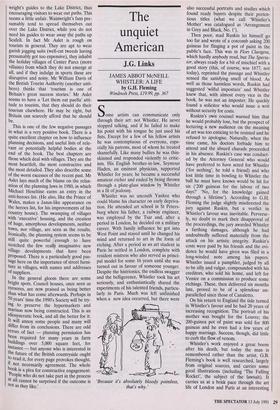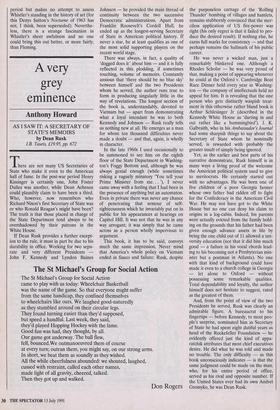The unquiet American
J.G. Links
JAMES ABBOT McNEILL WHISTLER: A LIFE by G.H. Fleming Windrush Press, £19.99, pp. 367 Some artists can communicate only through their art: not Whistler. He never stopped talking, and if he failed to make his point with his tongue he just used his fists. Except for a few of his fellow artists he was contemptuous of everyone, espe- cially his patrons, most of whom he treated shamefully. Like many bullies he was thin- skinned and responded violently to critic- ism. His English brother-in-law, Seymour Haden, an eminent physician, supported Whistler for years; he became a successful amateur etcher and ended by being thrown through a plate-glass window by Whistler in a fit of jealousy.
Whistler was no uncouth Yankee who could blame his character on early depriva- tion. He attended art school in St Peters- burg where his father, a railway engineer, was employed by the Tsar and, after a period in London, he decided on a military career. With family influence he got into West Point and stayed until he changed his mind and returned to art in the form of etching. After a period as an art student in Paris he settled in London, complete with resident mistress who also served as princi- pal model for some 16 years until she was turned out in favour of someone younger. Despite the histrionics, the endless swagger and the belligerence, Whistler took his art seriously, and enthusiastically shared the experiments of his talented friends, particu- larly in Paris. Much was left unfinished when a new idea occurred, but there were `Because it's absolutely bloody pointless, that's why.' also successful portraits and studies which found ready buyers despite their preten- tious titles (what we call 'Whistler's Mother' was catalogued as 'Arrangement in Grey and Black, No. 1').
Then poor, mad Ruskin let himself go too far and wrote of a coxcomb asking 200 guineas for flinging a pot of paint in the public's face. This was in Flors Clavigera, which hardly anybody read, but The Specta- tor, always ready for a bit of mischief with a good story (this, of course, was 1877, not today), reprinted the passage and Whistler sensed the satisfying smell of blood. As well as those harmless words, Ruskin had suggested 'wilful imposture' and Whistler knew that, with almost every vice in the book, he was not an imposter. He quickly found a solicitor who would issue a writ without security for costs.
Ruskin's own counsel warned him that he would probably lose, but the prospect of lecturing a new audience on the meaning of art was too enticing to be resisted and he refused to apologise. Naturally, when the time came, his doctors forbade him to attend and the absurd charade proceeded in his absence. Ruskin's case was conduct- ed by the Attorney General who would have preferred to have acted for Whistler (`for nothing', he told a friend) and who lost little time in bowling to Whistler the ball he must have known would be hit for six (200 guineas for the labour of two days?"No, for the knowledge gained through a lifetime'). According to G.H. Fleming the judge slightly misdirected the jury against Ruskin, but a verdict in Whistler's favour was inevitable. Perverse- ly, no doubt to mark their disapproval of the proceedings, the jury awarded Whistler a farthing damages, although he had undoubtedly suffered materially from the attack on his artistic integrity. Ruskin's costs were paid by his friends and the evi- dence he would have given was filed in a long-winded note among his papers. Whistler issued a pamphlet, judged by all to be silly and vulgar, compounded with his creditors, who sold his home, and left for Venice on a commission to produce some etchings. These, then delivered six months late, proved to be of a splendour un- parallelled since those of Canaletto.
On his return to England the tide turned in Whistler's favour and he had 20 years of increasing recognition. The portrait of his mother was bought for the Louvre; the 200-guinea pot of paint was sold for 800 guineas and he even had a few years of happy marriage. Success, though, did little to curb the flow of venom.
Whistler's work enjoyed a great boom after his death, but today the man is remembered rather than the artist. G.B. Fleming's book is well researched, largely from original sources, and carries some good illustrations (including 'The Falling Rocket', the subject of the lawsuit). It carries us at a brisk pace through the art life of London and Paris at an interesting period but makes no attempt to assess Whistler's standing in the history of art (for this Denys Sutton's Nocturne of 1963 has not, I think, been superseded). Neverthe- less, there is a strange fascination in Whistler's sheer awfulness and no one could bring this out better, or more fairly, than Fleming.



















































 Previous page
Previous page